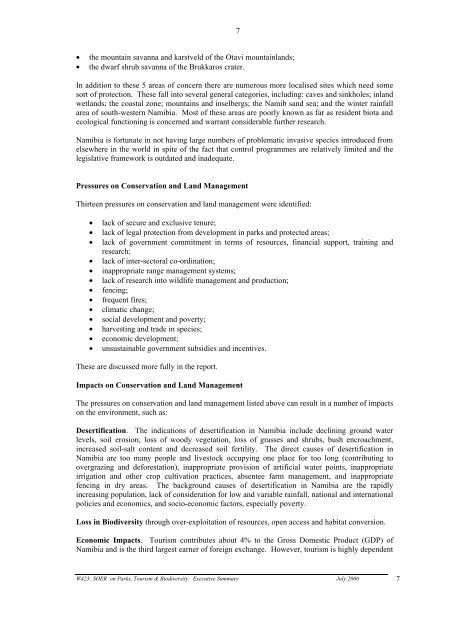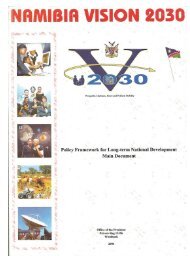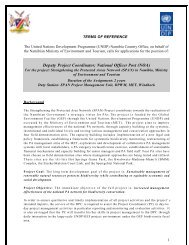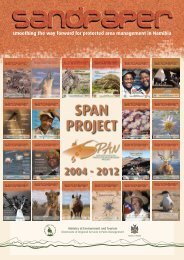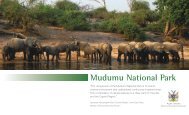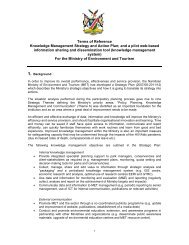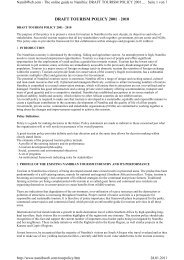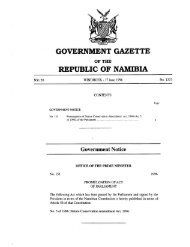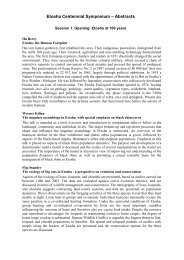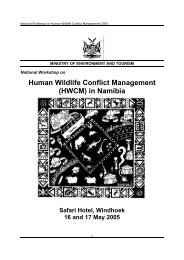EXECUTIVE SUMMARY - Ministry of Environment and Tourism
EXECUTIVE SUMMARY - Ministry of Environment and Tourism
EXECUTIVE SUMMARY - Ministry of Environment and Tourism
Create successful ePaper yourself
Turn your PDF publications into a flip-book with our unique Google optimized e-Paper software.
7<br />
• the mountain savanna <strong>and</strong> karstveld <strong>of</strong> the Otavi mountainl<strong>and</strong>s;<br />
• the dwarf shrub savanna <strong>of</strong> the Brukkaros crater.<br />
In addition to these 5 areas <strong>of</strong> concern there are numerous more localised sites which need some<br />
sort <strong>of</strong> protection. These fall into several general categories, including: caves <strong>and</strong> sinkholes; inl<strong>and</strong><br />
wetl<strong>and</strong>s; the coastal zone; mountains <strong>and</strong> inselbergs; the Namib s<strong>and</strong> sea; <strong>and</strong> the winter rainfall<br />
area <strong>of</strong> south-western Namibia. Most <strong>of</strong> these areas are poorly known as far as resident biota <strong>and</strong><br />
ecological functioning is concerned <strong>and</strong> warrant considerable further research.<br />
Namibia is fortunate in not having large numbers <strong>of</strong> problematic invasive species introduced from<br />
elsewhere in the world in spite <strong>of</strong> the fact that control programmes are relatively limited <strong>and</strong> the<br />
legislative framework is outdated <strong>and</strong> inadequate.<br />
Pressures on Conservation <strong>and</strong> L<strong>and</strong> Management<br />
Thirteen pressures on conservation <strong>and</strong> l<strong>and</strong> management were identified:<br />
• lack <strong>of</strong> secure <strong>and</strong> exclusive tenure;<br />
• lack <strong>of</strong> legal protection from development in parks <strong>and</strong> protected areas;<br />
• lack <strong>of</strong> government commitment in terms <strong>of</strong> resources, financial support, training <strong>and</strong><br />
research;<br />
• lack <strong>of</strong> inter-sectoral co-ordination;<br />
• inappropriate range management systems;<br />
• lack <strong>of</strong> research into wildlife management <strong>and</strong> production;<br />
• fencing;<br />
• frequent fires;<br />
• climatic change;<br />
• social development <strong>and</strong> poverty;<br />
• harvesting <strong>and</strong> trade in species;<br />
• economic development;<br />
• unsustainable government subsidies <strong>and</strong> incentives.<br />
These are discussed more fully in the report.<br />
Impacts on Conservation <strong>and</strong> L<strong>and</strong> Management<br />
The pressures on conservation <strong>and</strong> l<strong>and</strong> management listed above can result in a number <strong>of</strong> impacts<br />
on the environment, such as:<br />
Desertification. The indications <strong>of</strong> desertification in Namibia include declining ground water<br />
levels, soil erosion, loss <strong>of</strong> woody vegetation, loss <strong>of</strong> grasses <strong>and</strong> shrubs, bush encroachment,<br />
increased soil-salt content <strong>and</strong> decreased soil fertility. The direct causes <strong>of</strong> desertification in<br />
Namibia are too many people <strong>and</strong> livestock occupying one place for too long (contributing to<br />
overgrazing <strong>and</strong> deforestation), inappropriate provision <strong>of</strong> artificial water points, inappropriate<br />
irrigation <strong>and</strong> other crop cultivation practices, absentee farm management, <strong>and</strong> inappropriate<br />
fencing in dry areas. The background causes <strong>of</strong> desertification in Namibia are the rapidly<br />
increasing population, lack <strong>of</strong> consideration for low <strong>and</strong> variable rainfall, national <strong>and</strong> international<br />
policies <strong>and</strong> economics, <strong>and</strong> socio-economic factors, especially poverty.<br />
Loss in Biodiversity through over-exploitation <strong>of</strong> resources, open access <strong>and</strong> habitat conversion.<br />
Economic Impacts. <strong>Tourism</strong> contributes about 4% to the Gross Domestic Product (GDP) <strong>of</strong><br />
Namibia <strong>and</strong> is the third largest earner <strong>of</strong> foreign exchange. However, tourism is highly dependent<br />
W423: SOER on Parks, <strong>Tourism</strong> & Biodiversity: Executive Summary July 2000 7


